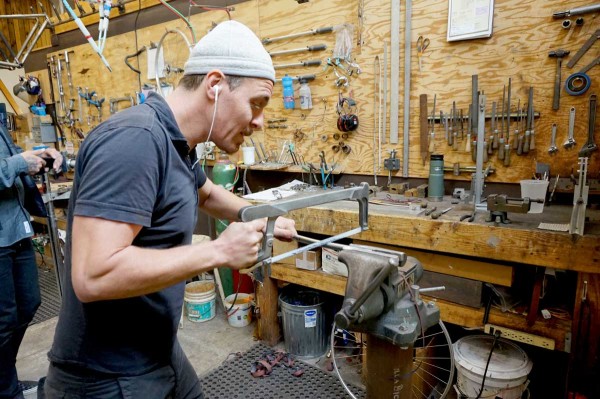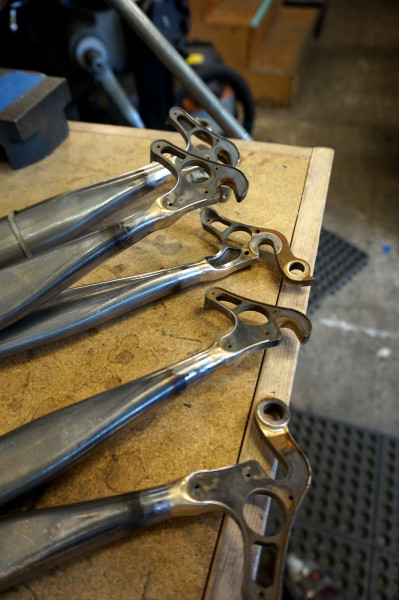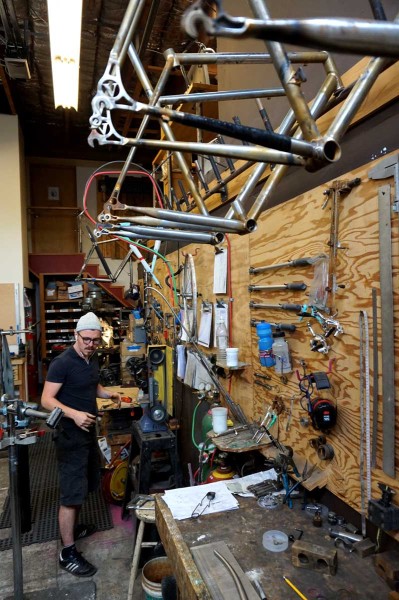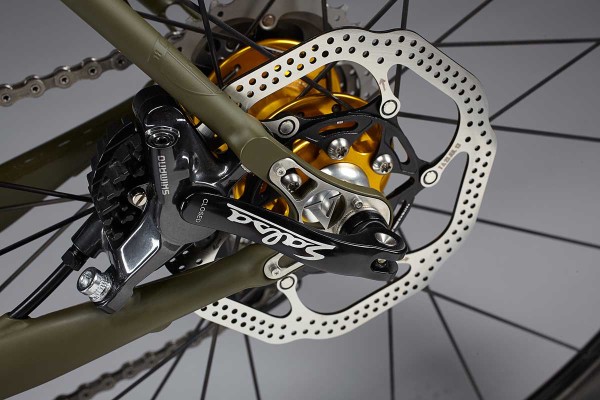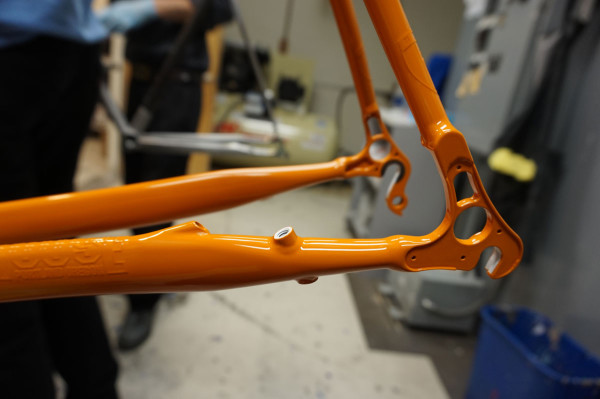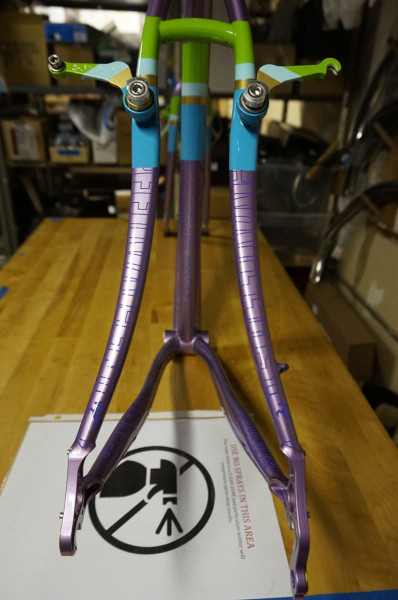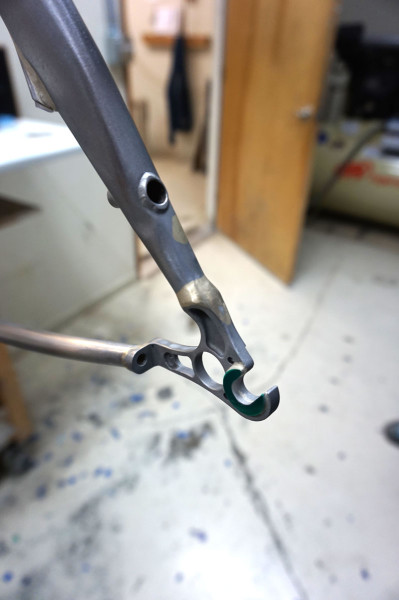In the early 2000’s, a class of small builders began to emerge as big domestic bike manufacturing continued its march towards overseas production. Rather than working their way up through years of different cutting processes, finish work, and ranks of existing factories or workshops (which were becoming fewer by the year) these new builders joined the game by jumping straight into frame building through classes at UBI or with individual builders and honed their craft through trial and error.
The captain of this class is Sacha White of Vanilla Workshop, a kid who knew what he needed to do with his life after watching a frame builder repair his broken messenger bike. After saving his pennies for the opportunity, he learned to build his first frame under Tim Paterek and has been working with a torch ever since. His obsessive attention to detail and visual and functional style in his bikes skyrocketed him to early rockstardom within the community and he has been working hard to live up to that hype.
Today, over fifteen years into the game, Sacha oversees a production house that contains both his Vanilla, for which he is the sole builder, and production Speedvagen lines and is currently gearing up for a West Coast fitting tour. Meet The Man from Vanilla after the jump.
BIKERUMOR: When people think of Vanilla, they have this romantic idea of just you by yourself with a torch. Coming into this workshop it’s clear that it’s much more sophisticated than that. It’s a production house. How have your priorities changed from initially picking up a torch to this point?
SACHA: When I first started building it was because I was racing and messengering and I saw these awesome bikes that were really turning me on that were hanging on the walls for sale in bike shops. Bikes like Sevens and IF’s and Waterfords. I wanted one of these bikes and I wanted to make these bikes for my friends. That’s where all of this came from.
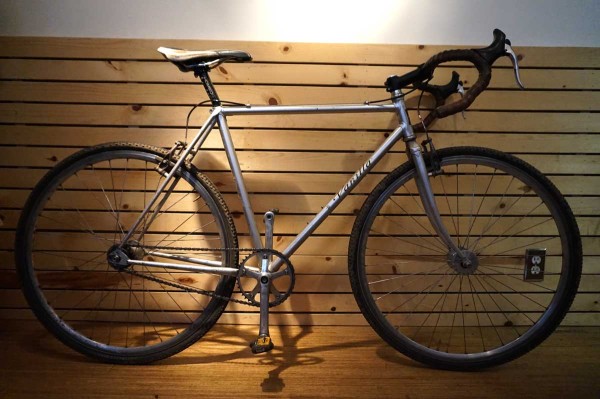
I guess it’s been an evolution from being very craft focused. We can only focus on what we know and understand. In the beginning I was very craft focused because whittling on a lug is very attainable for somebody who doesn’t know anything about bike design, who doesn’t know anything about fitting, who doesn’t know anything about business. And those are all important facets to a good bike company. But what I could grasp in the beginning was the handwork. So I really poured myself into that. And that’s why the bikes early on looked good and were completely dialed- at least aesthetically dialed- because that’s what was important to me.
And gradually the fit came along just from working on fitting people and from then riding myself and kind of comparing with what I was doing with fitting with what I was experiencing when I was riding. I was still racing a ton and building bikes for my teammates and building bikes for people that were buying them from me and racing so I was getting a lot of feedback on the design piece too.
So I would say that the design in terms of how the bike rides and the fit were coming along gradually and the business part, I mean, if we stepped back and looked at a graph of the trajectory of the different facets of me as a builder or of the business it was like Vanilla got super popular and so we got a ton of orders, meanwhile the business was not in the place to deal with that popularity. So the wait list ballooned and the craft piece was there, like the bikes looked good. The bikes were riding well, but the business side of it was on this very shallow trajectory.
A big reason why we stopped going to NAHBS was I realized that there were so many things inside of our shop that we weren’t doing as well as we were doing the bikes and I was frustrated with that. We weren’t going to focus on building hype or the brand or anything like that anymore until we got our ducks in a row here. I was conscious of taking a business from an adolescent phase to a mature kind of grown up adult phase of the business.
BIKERUMOR: And yeah, it is grown up.
SACHA: And along with that stuff- that has to do with having clear processes for customer service. Even basic stuff like checklists, which seem obvious, but all that stuff has to be developed. Everything in here is developed organically over time, usually as a solution to a problem. I’m the kind of person who does things by trial and error. That’s how I learned how to build bikes also.
It’s all of that stuff, all the way to our employees and what wages we pay and having profit sharing and pretty aggressive paid time off schedule. Family wages. That kind of thing.
I think a lot about not only what we do but why we do it, and is there actual value there or is it more… masturbatory.
BIKERUMOR: Great term.
SACHA: Well you know, like the builder slaving away in his shop. So okay, you spent 200 hours on your frame. Who gives a fuck? What does it ride like? What are all these other pieces that are actually worth something? I guess I just question the handmade thing and I only want to do it if there is real value there. I don’t want to do it because I’m patting myself on the back- a lot of stuff in Portland can be seen that way.
Yeah, so when I think about that, so we make 100 bikes, 120 to 140 bikes per year-
BIKERUMOR: Is that combined brands?
SACHA: Yeah. And we’ve got 10 full timers and a few part timers. So when you break that down and you think about human hours into each bike. That’s between 250-300 human hours into each bike that we’re sending out. That’s a shit ton of time going into a bicycle. So then I think about what do customers see and what do customers recognize. And do they see that? Do they recognize the value that comes from that? What are all of the things they are getting with that time as compared with a one man shop?
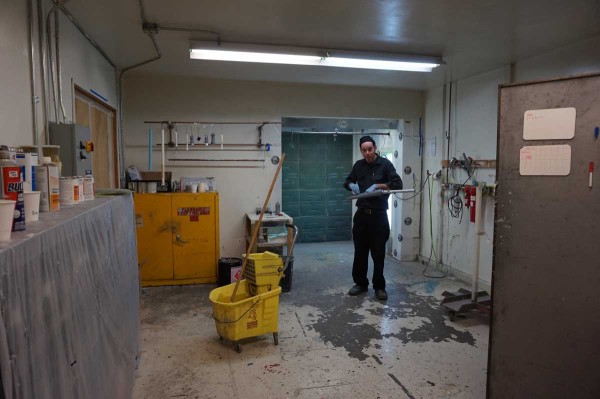
One thing they are getting are responses to their emails which is no small thing. They are also getting clear estimates. They are getting paint proofs. Essentially what they are getting is an experience that is dialed. It’s not just the frames that are dialed. It’s all of the customer interactions and it’s the finished product. And it’s being fitted.
It’s little things that are maybe mundane to talk about but it’s the kind of thing that ultimately makes a business a pleasure to deal with.
BIKERUMOR: What’s your lead time for a Speedvagen versus a Vanilla?
SACHA: Speedvagen is like two or three months. Vanilla is- I build about 15 of them a year and we have a list of four or five-hundred people.
BIKERUMOR: Can you talk a little about the origin of Speedvagen?
SACHA: The genesis of Speedvagen really came from those early days of Vanilla and comments online of “That’s too pretty to ride, you should hang that on the wall.” That’s not who I am. That’s pretty much 100% counter to what my sensibilities are. I like to make something that looks good and take it as far as I can take it, but there’s no part of that, that should then be hung on a wall. To me, a bike is not happy if it’s not being used.
Like I said, everything in here is a solution to a problem, and that’s what Speedvagen is. Speedvagen is a solution to what was a problem with the Vanilla model. The Vanilla model was super custom, basically prototypes every time. Although that’s enjoyable, what it turns into is inaccessibility. That can be inaccessibility with a wait list or inaccessibility with a price tag. But one way or another, I couldn’t build bikes for my friends or fellow racers or people who, like, my neighbor wants a bike and I can’t fucking build him a bike and I don’t have fucking time to do it.
BIKERUMOR: So it sounds like Speedvagen is your solution to broaden your impact.
SACHA: Mmhm. I’ve made an effort to grow the company in a way that I can actually build bikes instead of just being a manager. So now we have a management team and I’m on the floor building, I don’t know, ¾ of the time at least, which is totally the most satisfying part. If I can just be at the bench and just working on stuff, I’m absolutely the happiest.
BIKERUMOR: And you have people dealing with the stuff that would have you swearing under your breath all day long.
SACHA: Like bookkeeping or cutting checks or customer service…yeah, there are so many aspects that I’ve realized that I don’t want to do that- I’m actually not really good at it. Like Customer Service… I kind of take that shit personally. I get kind of snippy with people.
BIKERUMOR: Product evolution: each Vanilla is an evolving prototype. You’ve talked on it a couple of times in the past. So what does that evolution look like?
SACHA: A detail doesn’t make it onto our frames unless it has a purpose and I’d like to think that the purpose adds to the beauty of it. We do a lot of reinforcing with stainless on the Speedvagens and there is a design language to that. And there is a continuity of the design language that goes across different facets of the frame, so there is a beauty there but it’s ultimately there first for function and that’s to prevent paint from popping off of the bike.
BIKERUMOR: You’ve been doing disc brakes intermittently. But you have a new Speedvagen solution to it that is kind of crazy. Do you want to talk about that system in particular? First of all, does that rear part bolt up into [the seatstay]-
SACHA: Yeah
BIKERUMOR: Goddamn it. That’s pretty cool.
SACHA: Yeah, so we were working on prototypes for Disc and this is something team members were going to race on, the cross team. First we had a drawing that looked the same as the Speedvagen dropout currently but we had a shelf on the inside for the caliper to bolt to. It always looked chunky and not a great solution so I don’t think we even ever built a prototype for that but we definitely had a computer model and we were fucking around with that.
Then we settled on a Breezer-style dropout that- I actually mocked that whole thing up. We even had the frame built and I was like filing these massive holes in the seatstay, and then it occurred to us that oh, we already have a shelf that is going to the inside that we could mount to if we just raised it up a little bit. Then thinking about the braking forces going up into the frame rather than pulling on the dropout, and the benefits coming from that. It lightened up the whole situation and did great things for stress distribution.
BIKERUMOR: You didn’t have to have a brace.
SACHA: So we built one frame like that and Jeff Curtis was racing on that last year. And we built another one and sent it out for FEA testing before we built anymore for testing.
BIKERUMOR: Can you talk about these component collaborative efforts you have? The ENVE stem and the custom Paul brakes- how did those come about?
SACHA: I guess just ideas that I thought were good and that I wanted to push through. The stem with the integrated hanger so you’re getting rid of the external hanger and the flex and the weight and everything that comes with it. And the chatter that comes with that. How can we make this a reality? ENVE- we have a very strong relationship with them. So that was natural fit.
Paul, I’ve always used Paul brakes. They have that stainless shim that their brakes ride on so I looked at that- it’s this great, oversized stainless piece. That why, well, why don’t we just replace the little flexy cantilever piece all together with this and just make that bushing extend, and turn that into the new canti boss. I mean, that was a natural fit because it was actually a Paul design, that bushing was, so we just took it a step further.
BIKERUMOR: Are there other examples of you replacing existing standards, such as bolting from the bottom up with your disc mount?
SACHA: Speedvagen started with a cross bike. I looked at every different facet of a cross bike and thought, how can we kind of break from tradition or at least, not breaking from tradition for tradition’s sake, but are there things that have been done for 100 years just because they have been done for a 100 years.
The canti boss is a great example of that. Why would you have the brake sitting an inch off of the stay when that creates so much more leverage on the the stay itself that you’ll get a ton of flex out of that? Why would you have the brake sitting on a 6mm stud? It’s things like that or like on the road bikes- mounting the brake to a brake bridge- why just do that for a painted surface when every single bike that has a brake mounted to a painted surface, the paint bubbles up and blows off of that. That’s a subtle subtle change from the norm.
Oh- there’s actually a lot of this kind of stuff built into the Speedvagen track bike, which we only ever made a few of because it turns out that its hard to make the tubing. Things like instead of putting a bash guard on the outside of the top tube, we actually butt the tube so that it’s thick right there where it’s going to get smacked by the bar.
Things like dropouts have traditionally been two dimensional- they’ve been basically two dimensional, like they are cut from a plate of whatever material. Meanwhile, the rest of the frame is made from a tube. So why not make the dropout into more of a three dimensional structure, more of a tube-like structure rather than just leave it as two dimensional plate? So that’s kind of what’s going on with Speedvagen road dropouts, and that’s a lot of what’s going on with Speedvagen track dropouts. They are these deep truss structures.
BIKERUMOR: So somebody places an order for a Vanilla five years ago. They don’t have the bike yet. Due to Vanilla’s product evolution, what they are getting in the future is not nearly what they ordered, right? How do you rectify that?
SACHA: I rectify that- I mean, that’s something I didn’t foresee a long time ago, but now when people get their bikes, I’ve already had that conversation with them a long time ago that, hey, what I’m going to be building five or however many years from now is bound to be different. And if somebody is like, I really like this thing you were doing… I don’t really build with Stainless lugs anymore, polished stainless, it’s just glitz and it’s kind of a “hey look at me detail.”
So if somebody really wants that I’ll talk through my rational, the bikes are all better for all these reasons, and I don’t usually get a lot of push back on that.
BIKERUMOR: That’s interesting. Well with Richard Sachs, you get a Richard Sachs-
SACHA: And that would be my argument also. If you’re getting a bike from me, especially a Vanilla, you want the best of what I do, right? You know, that’s what I would say to the customer. What I’m doing now is definitely the best I can do.
Any Vanilla or Speedvagen you see on the road is the best possible bike we could build at that time. And will continue to be the case. So I think there is an understanding when someone is purchasing a bike that innovations and technology will change over time and that the bike they are getting is the best possible bike that could be made now. And that the bike that is going to happen 15 years from now will probably have a different feature set.
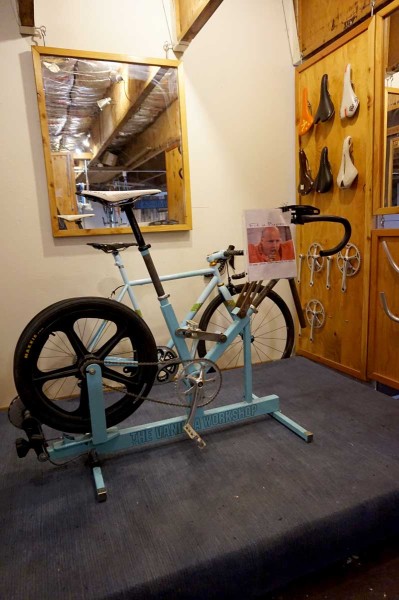
BIKERUMOR: So they place this order how ever long ago, do you call them up personally and re-talk about it? Do you re-fit them?
SACHA: Yeah, so that’s something that has changed over time too. I don’t fit people until it’s time to build their bike. And I don’t talk details until it’s time to build their bike. And this has happened in the past. If I had talked to somebody when then first placed their order they’re like “I totally want a fixed gear.” Meanwhile, here we are in 2015, and people want road bikes.
Pretty much as far back as I could remember, maybe in the first half of the time I’ve been building- I probably had to have those conversations. Now I’ll email somebody and say “hey, you’ve been waiting for a long time, and now it’s time to get ready to go.”
BIKERUMOR: You email them the golden ticket.
